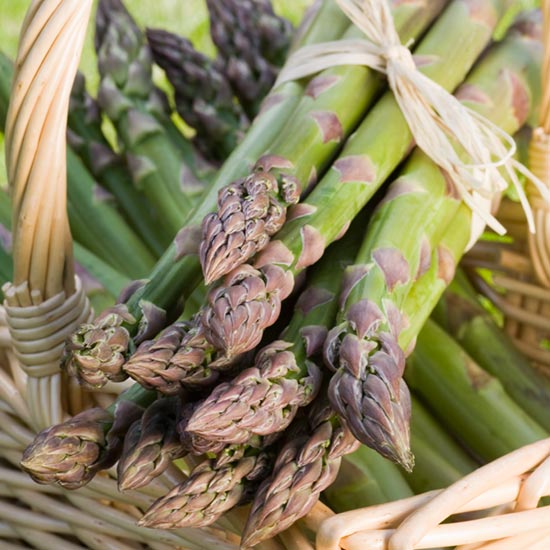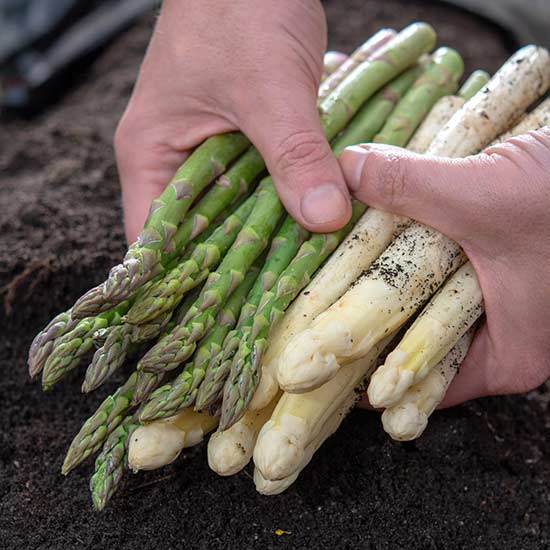How much, how soon and for how long?
Harvesting asparagus is one of the most rewarding experiences for any gardener. Those tender, succulent spears emerging in spring signal the beginning of the growing season and offer a delicious treat vastly superior to store-bought options. If you’ve planted asparagus crowns from Pomona Fruits, you’re in for a pleasant surprise – you can begin your asparagus harvesting journey earlier than most gardeners expect.
The advantage of Pomona Fruits asparagus crowns
While conventional wisdom suggests you should not harvest any spears in the first year after planting, this rule changes when you’ve planted high-quality asparagus crowns from Pomona Fruits. Thanks to our large one-year-old asparagus crowns which establish quickly and vigorously, you can harvest your first crop just one year after planting. This is because the much better size of our crowns means they’re strong enough to produce spears worth harvesting sooner than those typically offered for sale in garden centres.
There’s an important caveat – when harvesting asparagus in the first year, do so sparingly. This light harvest allows your asparagus plants to continue building strong root systems while still providing you with a taste of what’s to come in future years.
When to harvest asparagus in the UK
The asparagus harvest season in the UK typically runs from mid-April to mid-June, with the peak season occurring in May. The exact asparagus harvest dates depend on your location and the weather conditions of that particular year.
For Pomona Fruits asparagus crowns:
- First year after planting: A light, sparing harvest from mid-April to early May.
- Second year: A moderate harvest from mid-April to late May.
- Third year onwards: Full harvest from mid-April to 12 June.
After 12 June, it’s best to stop harvesting and allow the plants to develop ferny foliage. This post-harvest growth period is crucial as it allows the plants to photosynthesise and store energy in the crowns for next year’s crop.
How to harvest asparagus – cut or snap?
There are two main methods for harvesting asparagus, and both have their merits:
The cutting method
Use a sharp, serrated knife to cut the spears approximately 2.5cm (1 inch) below the soil surface. Take care not to damage any developing shoots nearby. This precise method allows you to harvest exactly what you want without disturbing the crown.
The snapping method
Simply bend the spear with your fingers until it snaps naturally. Asparagus spears break at the point where the tender part meets the tougher, fibrous base – meaning you get only the most tender portion with no waste. This method is quicker but may leave some edible portion in the ground.
Whichever method you choose, always harvest asparagus spears when they reach 12-18cm (5-7 inches) in height, before the tips begin to open. Once the ferny tips start to unfurl, the spears become woody and less flavourful.
How long to harvest asparagus each year
The harvesting duration increases as your asparagus bed matures:
- First year after planting (Pomona Fruits crowns): Harvest lightly for 2-3 weeks (so long as the plants have established well).
- Second year: Harvest for 4 weeks.
- Third year onward: Harvest for the full 8-week season (mid-April to 12 June).
What happens if you don’t harvest asparagus?
If you don’t harvest your asparagus spears, they will naturally grow into tall, ferny fronds that can reach heights of 1.5m (5ft). While this fern growth is essential during the post-harvest period, allowing all spears to develop into ferns during the harvest season has drawbacks:
- You miss out on delicious asparagus spears.
- The plants expend energy growing ferns rather than developing stronger crowns.
- Unharvested beds can become overcrowded and produce thinner spears in subsequent years.
- Excessive fern growth can create dense shade, making it harder to spot asparagus beetle infestations.
Regarding pests, look for asparagus beetles (distinctive black and orange beetles) that can damage your crop. If hand removal isn’t feasible, use an appropriate pesticide according to the manufacturer’s instructions.
On heavier soils, slugs can severely damage newly emerging shoots below ground level. To combat this invisible enemy, consider using parasitic nematodes (Phasmarhabditis sp.) watered into the soil. These nematodes effectively control slugs underground where traditional methods can’t reach.
Harvesting for longevity
A well-maintained asparagus bed planted with crowns from Pomona Fruits can remain productive for up to 20 years. To ensure this longevity:
- Always stop harvesting by 12 June each year.
- Allow the ferns to grow and die back naturally.
- Cut down the yellow foliage in autumn to about 2.5cm (1 inch) above ground.
- Apply a layer of compost or well-rotted manure in autumn.
- Apply a general fertiliser in spring.
- Keep the bed weed-free to prevent competition for nutrients.
Enjoying your asparagus harvest
Freshly harvested asparagus is at its sweetest and most tender when cooked within hours of cutting. Simply steam the spears and serve with melted butter or Hollandaise sauce for a quintessential taste of spring and early summer. The unparalleled flavour of home-grown asparagus makes all your patience and care worthwhile.
For more detailed information on establishing your asparagus bed, visit our comprehensive guide to planting an asparagus bed.
Want to expand your asparagus growing knowledge? Read our asparagus crowns growing guide for expert advice on varieties, soil preparation and year-round care.


